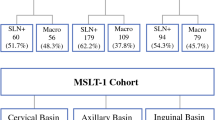Abstract
Background and Methods: Depending on the location of the primary lesion, melanoma patients may develop metastases in more than one regional lymph node basin. To determine whether this is prognostically significant, we reviewed our experience with melanoma patients who had undergone regional lymphadenectomy (RLND) in two separate basins.
Results: Of 3,603 patients who underwent RLND between April 1971 and January 1993, 406 underwent procedures in two separate basins; of these, 120 (30%) had metastases in both basins and 124 (30%) had metastases in one basin. When calculated from the first positive RLND, 1-year, 3-year, and 5-year survival rates were 82%, 48%, and 33%, respectively, for patients with dual-basin involvement and 88%, 59%, and 48%, respectively, for patients with single-basin involvement (p=0.0173). Median survival from the first positive RLND was 33.5 months for dual-basin involvement and 56.6 months for single-basin involvement. Univariate analysis demonstrated that Breslow thickness of the primary melanoma, clinical status of the regional lymph nodes, number of positive RLNDs, and tumor burden (total number of positive lymph nodes) were significant indicators of survival. The patient's age and gender, the anatomic location and Clark level of the primary melanoma, the disease-free interval before regional metastasis, and the site and timing of RLNDs were not significant by univariate analysis. Multivariate analysis demonstrated significance for Breslow thickness, number of positive RLNDs, and tumor burden.
Conclusions: The survival rate of melanoma patients with regional metastases in two lymph node basins is lower than that of patients with an equal tumor burden confined to a single basin. This suggests that primary melanomas metastasizing to more than one lymph node basin may have a higher metastatic potential, or that dual-basin involvement may increase the risk of systemic spread. We advocate lymphatic mapping, sentinel node biopsy, and selective lymphadenectomy as a cost-effective technique with little morbidity to identify and manage occult metastases in patients who have two lymph basins at risk.
Similar content being viewed by others
References
Robinson DS, Sample WF, Fee HJ, Holmes EC, Morton DL. Regional lymphatic drainage in primary malignant melanoma of the trunk determined by colloidal gold scanning.Surg Forum 1977;28:147–8.
Fee HJ, Robinson DS, Sample WF, Graham LS, Holmes EC, Morton DL. The determination of lymph shed by colloidal gold scanning in patients with malignant melanoma: a preliminary study.Surgery 1978;84:626–32.
Holmes EC, Moseley HS, Morton DL, Clark W, Robinson D, Urist MM. A rational approach to the surgical management of melanoma.Ann Surg 1977;186:481–90.
Coit DG, Rogatko A, Brennan MF. Prognostic factors in patients with melanoma metastatic to axillary or inguinal lymph nodes. A multivariate analysis.Ann Surg 1991;214:627–36.
Barth RJ Jr, Venzon DJ, Baker AR. The prognosis of melanoma patients with metastases to two or more lymph node areas.Ann Surg 1991;214:125–30.
Morton DL, Wong JH, Kirkwood JM, Parker RG. Malignant melanoma. In: Holland JF, Frei E, Bast RC Jr, Kufe DW, Morton DL, Weichselbaum RR, eds.Cancer medicine. 3rd ed. Philadelphia: Lea & Febiger, 1993:1793–824.
Sappey MPC. Anatomie, physiologie, pathologie, des vais-seaux lymphatiques consideres chez l'homme et les vertebres. Paris: A. DeLahaye and E. Lecrosnier, 1874.
Wanebo HJ, Harpole D, Teates CD. Radionuclide lymphoscintigraphy with technetium antimony sulfide colloid to identify lymphatic drainage of cutaneous melanoma of ambiguous sites in the head and neck and trunk.Cancer 1985;55:1403–13.
Lamki LM, Logic JR. Defining lymphatic drainage patterns with cutaneous lymphoscintigraphy. In: Balch CM, Houghton AN, Milton GW, Sober AJ, Soong S-j, eds.Cutaneous melanoma. 2nd ed. Philadelphia: JB Lippincott, 1992:367–75.
Morton DL, Wen D-R, Wong JH, et al. Technical details of intraoperative lymphatic mapping for early stage melanoma.Arch Surg 1992;127:392–9.
Uren RF, Howman-Giles RB, Shaw HM, Thompson JF, McCarthy WH. Lymphoscintigraphy in high-risk melanoma of the trunk: predicting draining node groups, defining lymphatic channels and locating the sentinel node.J Nucl Med 1993;34:1435–40.
Morton DL, Wen D-R, Foshag LJ, Essner R, Cochran AJ. Intraoperative lymphatic mapping and selective cervical lymphadenectomy for early-stage melanomas of the head and neck.J Clin Oncol 1993;11:1751–6.
Author information
Authors and Affiliations
Rights and permissions
About this article
Cite this article
Dale, P.S., Foshag, L.J., Wanek, L.A. et al. Metastasis of primary melanoma to two separate lymph node basins: Prognostic significance. Annals of Surgical Oncology 4, 13–18 (1997). https://doi.org/10.1007/BF02316805
Received:
Accepted:
Issue Date:
DOI: https://doi.org/10.1007/BF02316805




